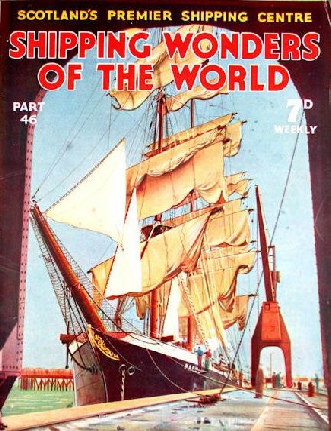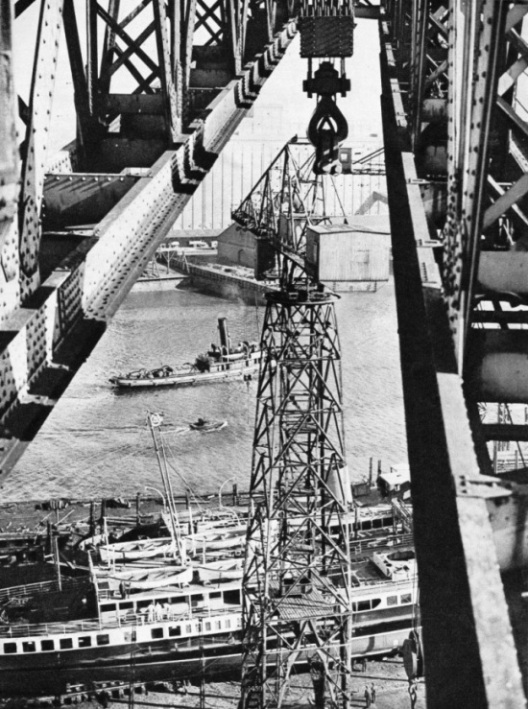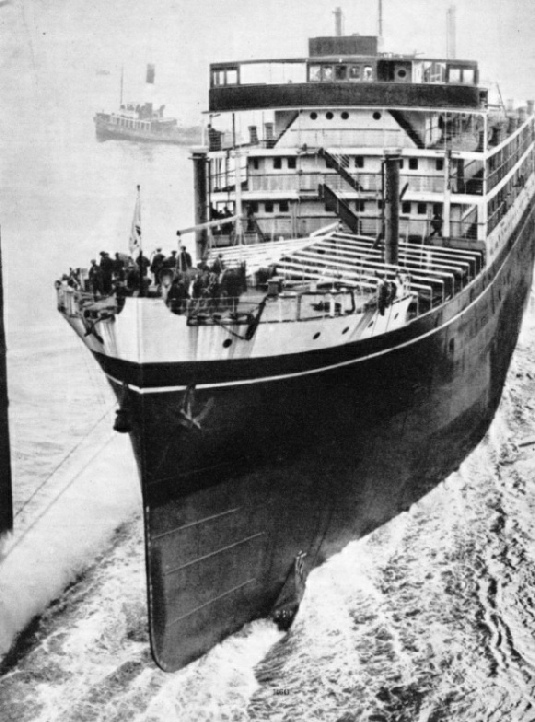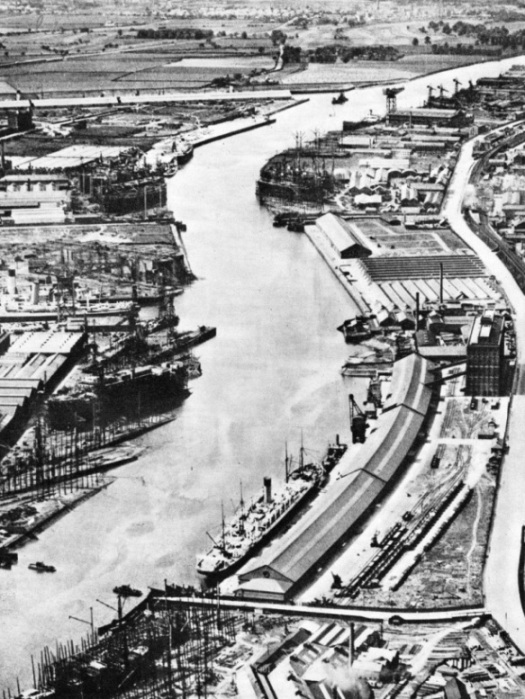
© Shipping Wonders of the World 2012-



Part 46
Part 46 of Shipping Wonders of the World was published on Tuesday 22nd December 1936.
It included a centre photogravure supplement illustrating the industries along the River Clyde, which formed part of the article on Scotland’s Premier Shipping Centre.
The Cover
The attractive cover this week shows the steel four-masted barque Parma in Barry Dock, near Cardiff. The Parma was built in 1902, and has a gross tonnage of 3,047. She ha a length of 327 ft 8 in, a beam of 46 ft 6 in and a depth of 26 ft 2 in. She was recently sold to become a coal hulk at Haifa, Palestine.

Contents of Part 46
The Battle of Tsushima
The defeat of the Russian Baltic Fleet on May 27 1905, by the Japanese Fleet in the Strait of Tsushima. This chapter is concluded from part 45 and is the sixth article in the series on Decisive Naval Actions.
Survey Ships at Work
The safe navigation of ships in every corner of the Seven Seas depends mainly on the accurate and painstaking work of a handful of surveying vessels which collect information for the making of charts. This chapter describes the work of early surveyors, and the processes of modern surveying, tells of the growth of the Hydrographic Department of the Admiralty, and gives the strange and little-known story of the Avocet Rock in the Red Sea.
Glasgow - Scotland’s Premier Shipping Centre
Along the banks of the River Clyde from Glasgow to Greenock are situated some of the biggest shipbuilding yards in the world. With the development of her shipping activities Glasgow has risen from a small town to the sixth largest city in the British Empire. Glasgow’s present eminence has been achieved through the energy and industry of her citizens during the last hundred years. To enable large vessels to reach Glasgow, every foot of the River Clyde has been dredges, down to Dumbarton, and the process of dredging has to be carried on ceaselessly to prevent the Clyde from silting up again.
This chapter is the thirteenth article in the series on Great Ports of the World.
Scotland’s Premier Shipping Centre (photogravure supplement)
Contents of Part 46 (continued)
China River and Coast Ship
A description of an unusual ship type particularly designed to operate on sections of the China Coast and on the Yangtze Kiang. This twin-screw vessel was built and engined in 1921 by the Hongkong and Whampoa Dock Company for the Indo-China Steam Navigation Company , Hongkong. She is named Kung Wo and is a ship of 4,636 tons gross, with a length of 350 feet, a beam moulded of 48 ft 6 in and a depth of 14 feet. This is the thirty-sixth article in the series on Merchant Ship Types.
Menace of Fire at Sea
One of the most dreaded of all the dangers to which a ship at sea may be subjected is fire. Gradually, however, the imposition of stricter regulations and the application of many protective and preventive devices have almost eliminated the risk of a serious fire in a modern vessel. In the days of wooden warships, fire was the constant dread of sailors. So great was the fear of fire that smoking was prohibited anywhere but on the forecastle head. Nowadays the means of preventing fires are so much improved, and with steel ships the risk is so much less, that regulations need not be so strict, except for tankers. This chapter describes the modern precautions against outbreaks and tells of one or two historic instances of disasters through fire.
Marine Measurements
Ships are so immense that comparisons are difficult except on certain common measurements. The principles on which the various tonnages and other standards of capacity or water displacement are clearly outlined in this review of the subject.
HM Coastguard Service
The Coastguard Service was brought in 1922 under the control of the Board of Trade and reorganized into two divisions - the Coast Watching Force, concerned with life-saving and the salvage of wreckage, and the Coast Preventive Corps, concerned mainly with the prevention of smuggling.
Raising the Maine
A mysterious explosion sent the United States battleship Maine to the bottom of Havana Harbour, Cuba, on February 15, 1898. Fourteen years later the battleship was refloated after extensive salvage operations. Contrary to expectations, the cause of the explosion was not definitely ascertained. This chapter describes how the American warship was raised in spite of almost insuperable difficulties. This is the ninth article in the series Dramas of Salvage and is concluded in part 47.
Scotland’s Premier Shipping Centre: Photogravure Supplement
SEEN FROM A MAMMOTH CRANE, the River Clyde has the appearance of a long narrow dock basin. In the distance is the Meadowside Granary, which has a storage capacity of 31,000 tons. Quays 1,616 feet in length surround the granary, and vessels drawing 34 feet of water can discharge alongside.
Scotland’s Premier Shipping Centre - 2
A RIVER CLYDE LAUNCH is generally made at an angle to the stream because of its narrowness. The launch of the Famaka from Alexander Stephen's yard at Govan in 1922 followed this procedure. This vessel is a steamer of 5,832 tons gross, built for the Khedivial Mail service in the Mediterranean. She was sold to Eastern Traders Ltd, and renamed Ormiston. She has length of 390 ft 9 in, a beam of
55 ft 3 in and a depth of
28 ft 1 in and is registered at Melbourne, Australia.
Scotland’s Premier Shipping Centre - 3
HIGHWAY TO GLASGOW. From Renfrew to the docks at Glasgow and the Broomielaw, the River Clyde is lined with shipbuilding yards, quays, decks and wharves. Constant dredging keeps the channels deep enough for ocean-going ships. The Clyde was once a shallow swiftly-flowing salmon river, navigable by small boats only.
Scotland’s Premier Shipping Centre - 4
IN THE FITTING-OUT BASIN of John Brown and Company’s shipbuilding yard at Clydebank. Numbers of workmen are seen coming off duty from the Queen Mary during her fitting-out. Shipbuilding is the most important industry on the Clyde, and this famous yard is described in the chapter “Where the Queen Mary was Built”. In June 1936 forty-two vessels were under construction at Greenock and Glasgow yards.



